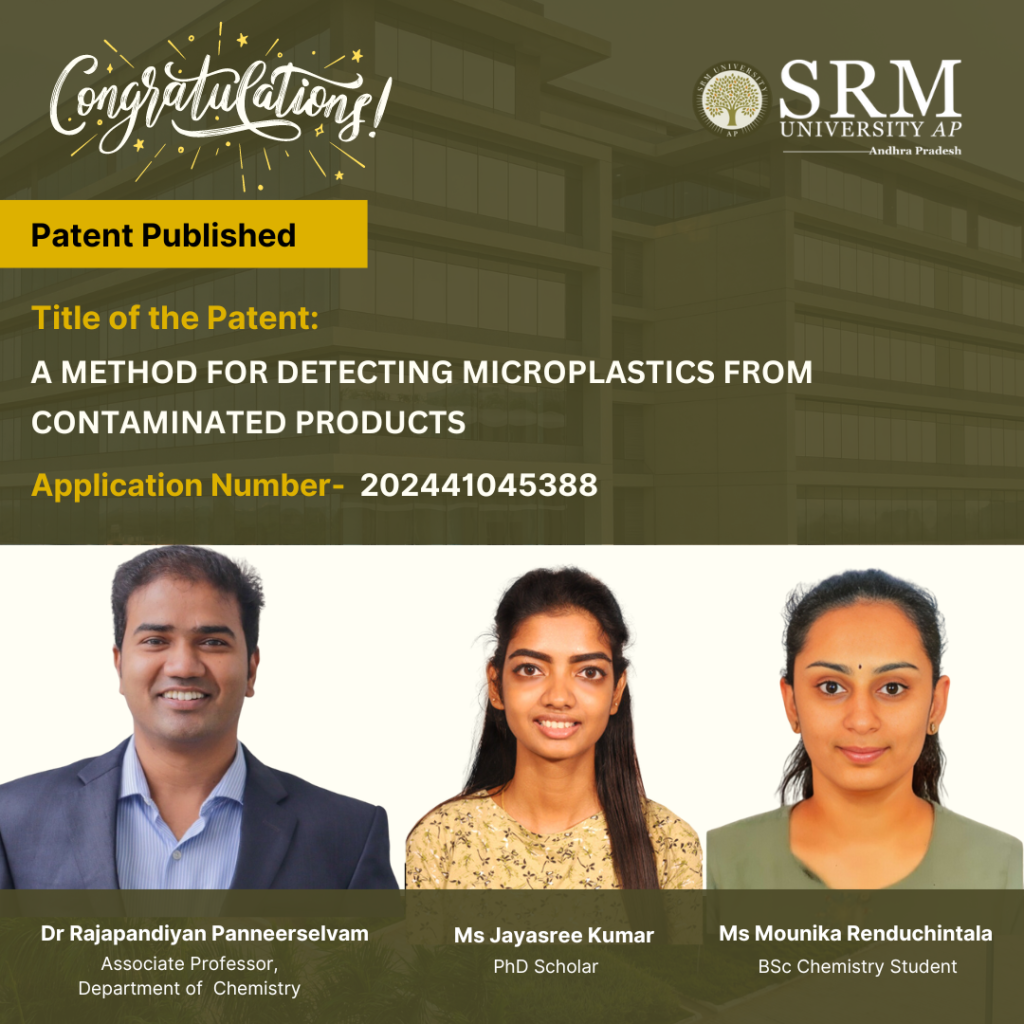
The Department of Chemistry is glad to announce that Dr Rajapandiyan Panneerselvam, Associate Professor, Ms Jayasree K, Research Scholar, and Ms Mounika Renduchintala, BSc student, have had their breakthrough research published as a patent titled “A Method for Detecting Microplastics from Contaminated Products” with Application Number: 202441045388. Various research has been undertaken by scientists in developing improved methods for sample preparation and data analysis, aiming to reliably detect pollutants like microplastics in complex samples such as sea salt, soil, and water. In line with these efforts, this patent introduces a rapid and easy method to detect microplastics in contaminated products and water bodies using a filter paper-based substrate.
Abstract
Surface-enhanced Raman spectroscopy (SERS) has emerged as one of the most promising analytical tools in recent years due to its advantageous features, such as high sensitivity, specificity, ease of operation, and rapid analysis. These attributes make SERS particularly well-suited for environmental and food analysis. However, detecting target analytes in real samples using SERS faces several challenges, including matrix interference, low analyte concentrations, sample preparation complexity, and reproducibility issues. Additionally, the chemical complexity of pollutants and environmental factors can impact SERS measurements. Overcoming these hurdles demands optimized experimental conditions, refined sample preparation methods, and advanced data analysis techniques, often necessitating interdisciplinary collaborations for effective analysis. Therefore, our focus lies in the development of various methods for fabricating SERS substrates, pretreating analytes, and devising sample preparation strategies. These efforts aim to enable the detection of analytes like microplastics within complex real samples, including sea salts, soil samples, lake water, and various food products.
Practical Implementation/ Social Implications of the Research
SERS Community: Introducing a facile fabrication method for developing filter paper-based substrates, utilizing evaporation-induced self-assembly methods with the aid of 96-well plates. These substrates boast exceptional sensitivity and uniformity, exhibiting a relative standard deviation (RSD) of 8.2%. They offer easy fabrication and serve as effective SERS substrates for various applications.

Industry and Government Bodies: This invention plays a pivotal role in assessing contamination in food and water bodies, serving as a crucial tool in monitoring environmental contamination through on-site analysis with portable instruments. It ensures adherence to regulatory standards and safeguards public health.
Research: Beyond its practical applications, the invention supports scientific research endeavors focused on identifying microplastic contaminants in real-world samples using portable Raman spectrometers. This not only aids ongoing research but also paves the way for future studies in this critical field.
Collaborations
- Dr Hemanth Noothalapati – Raman Project Center for Medical and Biological Applications, Shimane University, Japan
- Dr Murali Krishna C – Advanced Centre for Treatment, Research and Education in Cancer, Tata Memorial Centre, Navi Mumbai, India
- Dr Soma Venugopal – University of Hyderabad, India
The research team hopes to develop a novel SERS substrate for the detection of environmental pollutants in real-world samples.

